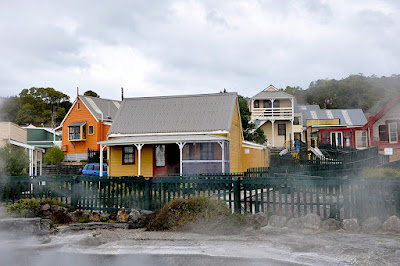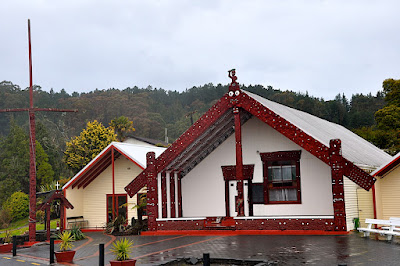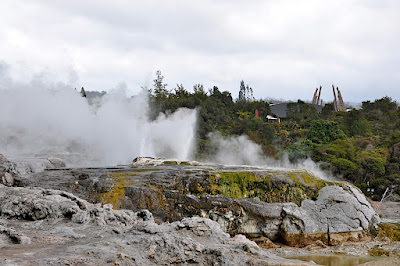Seems that my cold got the better of me and I slept until almost 9:30 AM on my first full day in Rotorua but luckily awoke in time to have cereal, juice, coffee and a sweet roll at the breakfast provided by the
Ventura Inn & Suites of Rotorua, my home away from home in Rotorua. The weather was not terribly promising and I certainly wasn't feeling well enough to tackle an all day adventure. So I organized myself for a visit to
Whakarewarewa Thermal Village, a "living thermal village" a short distance away from my motel.
Hoping for the best in terms of the weather, I managed to find parking a couple of blocks away from the visitor center for Whakarewarewa (often shortened to Whaka by the locals), paid my entry fee AND discovered the reason for the lack of parking is that there had been a funeral that morning at the Wahiao Whare Tipuna (Whare Tipuna = Ancestors House). This is not only where they hold their funerals but is the Meeting House for all the major events of the Village. From the Visitor Guide I learned that
The best of all Maori carving is saved for the Whare Tipuna. The carver takes pride in displaying all his skills and knowledge as he recreates Whakapapa (genealogy) for all to see. Without a written language he recreates a story through his carvings. The house is named "Wahiao" after our great ancestor.The tour began with our guide standing in front of the sign post naming the village by both the original full name of
Te Whakarewarewatanga O Te Ope Taua Wahiao and the shorter Whakarewarewa (still somewhat unpronounceable for native English speakers). The name of the village translates to mean "The gathering place of the army of Wahiao" and adopted this name in honor of Chief Wahiao who, three hundred years ago, gathered an army to successfully avenge the killing of his father.
As our tour continued, we learned many things about life in this Maori Village, including that corn is boiled daily (for the Hangi Feast served as lunch at the café in the village) in Parekohuru (Vigorous Ripples) pool.
And we learned that the modern homes in "Whaka" village use both thermal and solar energy to meet their energy needs. (an original Maori home built using thermal energy may be seen on my
photoblog)
Once the tour ended, we were encouraged to go visit the meeting house which had been off limits to tours due to the funeral earlier in the day. But respectful visitors were allowed to stop by on their own which led me to take the photo below from the porch of the café across the street and slightly uphill.
I'd planned to take one of the longer hikes available to visitors as self-guided tours, but the pouring rain that started shortly after the formal tour ended discouraged me from doing that. The following photograph was taken from Pohutu Geyser Lookout and the strange structure visible above the trees across the way is part of the Te Puia Village museum complex.
A return trip to Rotorua would definitely have me visiting Te Puia Village since it is the village where Maori craftsmen and women demonstrate their time-honored crafting traditions and of course, sell their wares to tourists wishing to purchase souvenirs.






No comments:
Post a Comment